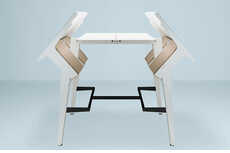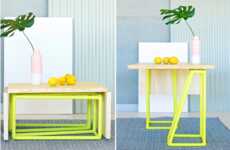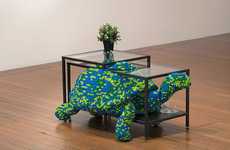
This Reforming Coffee Table is an Example of Functional Art
Jen Chae — July 30, 2013 — Art & Design
References: ellenjantzen
This coffee table is an example of functional art. This prototype, titled the Interactive Reformable CoffeeTable, is one of Michael Jantzen's interactive functional furniture series. The table is unconventional to say the least -- it looks more like a complex puzzle than furniture.
This geometrically diverse table consists of six wedges that are mounted on wheels -- each pivots around the center column with ease. As the segments move around freely, the entire shape of the table changes, making it a reforming artistic piece.
Reforming furniture would be ideal for those who like to switch up interior design often. The table's shapes, sizes, colors and materials could vary, depending on the desired effect. This specific prototype is made of wood and a white laminate surface, but if it was made of steel, it would give off a completely futuristic appeal.
This geometrically diverse table consists of six wedges that are mounted on wheels -- each pivots around the center column with ease. As the segments move around freely, the entire shape of the table changes, making it a reforming artistic piece.
Reforming furniture would be ideal for those who like to switch up interior design often. The table's shapes, sizes, colors and materials could vary, depending on the desired effect. This specific prototype is made of wood and a white laminate surface, but if it was made of steel, it would give off a completely futuristic appeal.
Trend Themes
1. Functional Art - Disruptive innovation opportunity: Explore new possibilities for combining functionality and artistic expression in furniture design.
2. Interactive Furniture - Disruptive innovation opportunity: Develop interactive furniture pieces that can be easily transformed and reconfigured by the user.
3. Reforming Design - Disruptive innovation opportunity: Create furniture with modular components that can be rearranged to fit different aesthetic preferences and spatial needs.
Industry Implications
1. Furniture Design - Disruptive innovation opportunity: Integrate technology and materials to create furniture that adapts to changing user preferences and interior design trends.
2. Interior Design - Disruptive innovation opportunity: Incorporate unconventional furniture pieces that provide flexibility and creative possibilities in interior spaces.
3. Material Innovation - Disruptive innovation opportunity: Explore new materials and production techniques to enable the creation of transformable and customizable furniture designs.
2.8
Score
Popularity
Activity
Freshness























